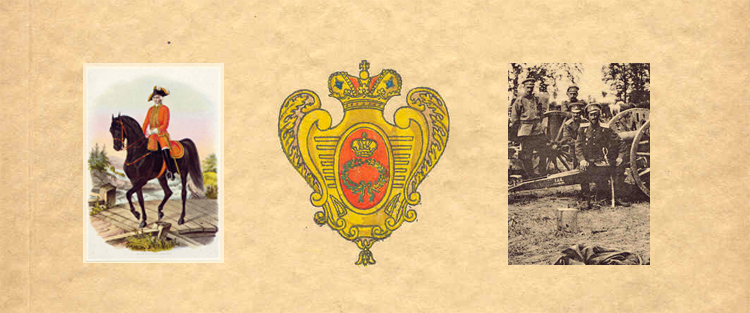Slave to the Game
Online Gaming Community
ALL WORLD WARS
RUSSIAN HORSE GUARDS COMMEMORATIVE MANUAL
1706-1931
Preface and Illustrations
PREFACE
The present volume is a Hand Book of the Horse Guards published by His Imperial Highness Grand Duke Dmitri of Russia, President: of Honor of the Association of Former Officers of the Horse Guards, Imperial Russian Guards, on the occasion of the commemoration of the 200th anniversary of the foundation of this regiment, which took place in Paris on April 26th, 1931.
This book contains a synopsis of the history of over two hundred years of loyal service rendered by the gallant regiment of The Horse Guards lo Emperor and country, which has been written by Colonel Vladimir Kozlianinoff, of the Horse Guards, late Aide de Camp to His Majesty the Emperor of Russia, the documents used being mostly older works on the history of the Horse Guards and to some extent documents as yet unpublished, found in exile.
Difficulties in the way of collecting duly authenticated documents pertaining to the history of the Horse Guards have, since the outbreak of the revolution in 1917, become extraordinarily great, and on the other hand it is now practically impossible to obtain a copy of any regimental history published in former years. The present volume may therefore rightly claim to be of the greatest interest to all lovers of military history.
Of this Hand Booklet five hundred numbered copies have been printed, of which two hundred and fifty, numbered 1 to 250, have been presented by H.I.H. Grand Duke Dmitri of Russia to Members of the Russian Imperial Family, to all members of the Association of Former Officers of the Horse Guards and to such former soldiers as have left their country, to a small number of regimental associations of former officers of the Imperial Russian Guards' Corps and to some National Libraries.
The two hundred and fifty remaining copies, numbered 251 to 500, are to be sold and any sums obtained by their sale to be employed for the purpose of endowing a Charity Fund of the Association of Former Officers of the Horse Guards which has been created in order to enable the Association to assist its members in old age or infirmity.
The illustrations contained in the present volume have been reproduced from paintings and engravings belonging to the Horse Guards' Museum in St. Petersburg; what their fate may have been since the revolution is not known. They form hut a part of the illustrations contained in the complete History of the Horse Guards at present being prepared for publication. In view of the extraordinary historical interest of the latter work which is to be printed in Russian, it has been decided to add to it a synopsis of its contents in English, French and German and explanatory notes to all the very numerous and rare illustrations contained therein in each of these three languages.
The History of the Horse Guards will be published in three large volumes in quarto raisin and a fourth volume containing biographical notices on all former officers from 1730 to the present day. Persons wishing to subscribe in advance to the complete edition which is to he limited to 150 copies issued in the name of each individual subscriber and containing a large number of coloured plates an illustrations, will kindly apply for any information desired to: Colonel Vladimir Kozlianinoff, c/o Lloyds et National Provincial Foreign Bank Ltd., 43, Boulevard des Capucines, Paris, France.
The Horse Guards were the oldest cavalry regiment in the Imperial Russian Guards' Corps whose Colonel-in-Chief was the reigning Emperor, and they enjoyed all the rights and privileges conferred upon them by their high rank. Most of the monarchs who reigned in Russia were placed on the rolls of the Horse Guards as Heirs Apparent on the very day of their birth. The constant favour in which Russian Sovereigns held the Horse Guards is also shown by the fact that most of the Grand Dukes of Russia were placed on their rolls and that a large number of officers were selected from the Horse Guards to join His Majesty's Suite. It may indeed be said that, as regards the number of their officers appointed to serve in His Majesty's Suite, the Horse Guards ranked first among the regiments of the Imperial Guards. Following His Majesty and the Heir Apparent, other Members of the Imperial Family placed on the rolls of the Horse Guards at the time of the outbreak of the revolution were: Grand Duke Paul of Russia and iris son Grand Duke Dmitri of Russia, Grand Duke Constantine and his brother Grand Duke Dmitri of Russia, Grand Duke Nicholas of Russia and Prince John of Russia.
Any young gentleman wishing to become an officer in the Horse Guards had to submit, before obtaining his commission, to a rigourous secret ballot by the Officers' Corps. In most cases candidates were young gentlemen whose ancestors, fathers or near relations had held commissions in the Horse Guards in former years. It was this selection founded to a great extent on the hereditary principle, that was responsible for the ardent love officers of the Horse Guards have always felt for the regiment to which they were bound by so many family ties and traditions, for the rigourous and rigid discipline loyally observed by them on duty as in private life, for their high concept of honour and duly and for their boundless loyalty and fidelity toward their Sovereign. All officers of the Horse Guards were personally known to H. M. the Emperor.
The Horse Guards formed part of the garrison of St. Petersburg and their service was therefore very brilliant, but also very expensive. Officers hardly ever received their pay; as a rule it scarcely sufficed to cover certain necessary expenses of regimental life. In order therefore to be in a position to hold a commission in the Horse Guards an officer had to be in possession of ample private means. Most of the officers of the Horse Guards, whether married or single, lived in large flats placed at their disposal in the regimental barracks. An orderly chosen .from among the men of his squadron was attached to the person of every officer.
The Horse Guards were mounted on black horses. Each officer was obliged to keep at least two chargers. Within the last ten years before the outbreak of the war many officers' chargers had been imported from England, and it was the high class of their mounts that enabled the Horse Guards' officers' team to win three of the four great four miles steeple chases run at Krasnoie Selo in the presence of the Emperor and thus to secure His Majesty's prize.
The uniforms worn by officers of the Horse Guards were very numerous, a special uniform having to he worn at nearly every official function. The men's uniforms were also highly elaborate, although less so than the uniforms of the officers. A detailed description of all uniforms will be a feature of the third volume of the History of the Horse Guards which will also contain a large number of coloured plates representing the various uniforms worn by the Horse Guards under successive reigns.
The Officers' Mess of the Horse Guards was one of the largest and most beautiful in St. Petersburg and contained a very great number of various works of art, to say nothing of the priceless collections belonging to the Horse Guards' Museum, to which presents due to the generosity of Russian Monarchs and to that of officers of the Horse Guards were constantly being added. The vestry of the cathedral of the Annunciation, the regimental church of the Horse Guards, also contained a large number of works of art of inestimable historic value, nearly all of which were presents of Emperors and Empresses of Russia.
The quarters occupied by the Horse Guards in St. Petersburg covered a large area limited by the Horse Guards' Boulevard (1) on one side, and by Post Street (2), Annunciation Street (3) and Great Sea Street (4) on the other. The ground floor was occupied by the regimental stables, above them on the first floor were the barrack-rooms of the four squadrons and the auxiliary companies, and on the second floor the flats occupied by officers and a few civil officials in the regimental service. Regimental quarters also comprised the. Great and the Small Riding Schools. All military exercise whether on foot or on horse-back took place at the Great Riding School and it was there that every year on March 25th., Our Lady's Annunciation Day and Commemoration Day of the Horse Guards, a solemn Te Deum was sung, followed by a review on foot held by H. M. the Emperor. Again the Great Riding School was the scene of regimental " concours hippiques " for officers and men as well as of riding exercise in which all officers took part under the personal supervision of the Commander or the senior colonel. And, finally, it was at the Great Riding School that all inspections by commanding generals, hearing of complaints, horse parades, inspections of senior and junior contingents etc. took place, as did also the traditional review held by each new commanding officer on entering upon his duties. In one word, the Great Riding School was the very centre of regimental life and activity, with hardly an interval, from 6 a.m. to 6 p.m.
The Small Riding School was much less in size, it was used by officers only and its character was more intimate. Every day all lieutenants and sub-lieutenants look their riding exercise there; there also horses were trained for the "concours hippique". In the evening, during Lent, officers sometimes arranged carrousels and gymkhanas at the Small Riding School to which officers' families and guests were invited. These functions usually included supper at which music was provided by the regimental brass hand and balalaikas. The brass and balalaika bands of the Horse Guards were among the best of the Guards' Cavalry bands and their repertoire was very large. The instruments used by them were made of silver and were presents of former regimental aides-de-camp. The brass band of the Morse Guards reached the acme of its artistic development under the eonductorship of Mr. Anthony Ruzek who filled the post of chief conductor during 25 years.
Every week, on Thursday, gala dinners were given at the Officers' Mess of the Horse Guards at which the presence of all officers was compulsory. Absence could only be excused on account of illness or by special dispensation granted by the senior colonel. All officers were entitled !o invite their male friends to these dinners (ladies not being admitted), but such invitations had to be sanctioned by the senior colonel or a squadron commander. The regimental brass band played at dinner and the balalaika band after dinner. Sometimes, later in the evening, the chorus of regimental singers was called for. The chair was taken at dinner by the Commander or, in his absence, by the senior colonel. Officers were seated at table in accordance with their rank and seniority, the seat at the lower end of the table opposite the Commander being always occupied by the officer in charge of the Mess. An invitation to a Horse Guards' dinner was considered to be a great honour, and especially so in the case of civilians. After dinner some officers usually played at nine-pins in a large hall set apart for this and other sports, such as fencing, gymnastics and the like, while others played billiards on the two large tables in the billiard room, or cards in the Green Salon. Sometimes, if called for, a cold supper would be served at about midnight, the first course always being a traditional " onion soup ". This supper was familiarly called a " cold morsel ". Bat even if officers only left the Mess in the small hours, they were all obliged to be present at morning exercise with their squadrons ; any officer failing to do so was severely punished.
The Horse Guards occupied their quarters in St. Petersburg during the whole of the winter season, but on May 1th /14th. they moved to Krasnoie Selo for exercise in the field. There the four squadrons and all auxiliary companies were quartered in wooden barracks, owned by the Horse Guards and forming a small borough in the centre of which stood the regimental Church of St. Olga. This church was a true reproduction of the Cathedral of the Annunciation in St. Petersburg and had been built under Commander Major General the Prince Nakhitchevansky, of II. M. Suite. H. I. H. Grand Duke Dmitri of Russia, a former officer of the Horse Guards, had presented the Officers' Corps of His old regiment with the house He had lived in at Krasnoie Selo. This house was built in the style of a Russian " isba "' and had two storeys, and into it the Officers' Mess of the Horse Guards moved for the summer months every year. Officers used to live in the village of Krasnoie. Selo in small peasants' cottages which they rented for the summer.
The Horse Guards were one of the richest regiments in the Imperial Russian Guards, a large number of charity funds having been created for their benefit by former officers either at the time of their resignation or by will. Each of these funds had a special statute and income derived from them was used to make awards to or financially to assist men of the Horse Guards and their families. At the time the Horse Guards left their quarters in 1914 to take part in the war the sum total of such charity funds amounted to 325.000 roubles (about £ 34.500.-.-.).
Before bringing this short description of life in the Horse Guards in recent years to a close,, we feel we ought to mention in a few words certain characteristic facts of regimental life in years further removed from our time.
During the first century of the existence of the Horse Guards, all commissioned officers belonged to the Russian nobility and their families were intimately related to and associated with the Imperial Court. In the " Leib Regiment " even the men had ail been scions of noble families or of the best families of the landed gentry. It often happened that a private in the " Leib Regiment " owned hereditary lands and serfs. It also often happened that of two brothers one would be a commissioned officer and the other a private in the " Leib Regiment ". As a result of this exclusive selection of officers and men the " Leib Regiment " and later the Horse Guards naturally came to be considered as a school and a noviciate for future officers of all other Russian cavalry regiments. It was this exclusive selection too that accounted for the fact that the moral tone and the traditions of both these regiments have always borne the stamp of nobility and independence.
Lack of space unfortunately prevents us from entering into many interesting details which lent a particular character to life in the Horse Guards. It is however necessary to mention some facts of which they may be justly proud. We shall therefore recall that the powerful Field Marshal, His Serene Highness Prince Gregory Potemkin, counsellor and friend to Empress Catherine II, had been a sergeant in the Horse Guards. Field Marshal Count Alexis Rasoumovsky, who was morganatically married to Empress Elisabeth of Russia, was a Vice-Colonel-in-Chief of the Horse Guards. Field Marshal and Marshal of Artillery, Count (later Prince) Gregory Orloff, who played an important part in the palace revolution which enabled Empress Catherine II to ascend the Russian Throne and was ever since Her loyal counsellor and trusted adviser, was also a Vice-Colonel-in-Chief of the Horse Guards, as also was the famous Field Marshal Count. Roumiantzeif-Zadounaisky. Prince Alexis Orloff, President of the Council of the Empire, Aide-de-Camp General and friend to Emperor Nicholas I, had first been an officer in and later in command of the Horse Guards. Lastly, Count Wladimir de Freedericksz, Aide-de-Camp General to H.M. Emperor Nicholas II and Captain-in-Chief of the 4th. Squadron of the Horse Guards, began his military career as an officer in the Horse Guards, was later appointed to command that regiment and afterwards filled the post of Minister of the Imperial Household, and his advice always carried great weight with His Majesty Emperor Nicholas II.
All these eminent officers of the Horse Guards were, thanks to their exalted rank and position, the natural counsellors and trusted advisers to the Emperors and Empresses of Russia and, at the same time, formed a connecting link between the Horse Guards and their Imperial Colonels-in-Chief.
The seniority of the Horse Guards dated back to June 16th., 1706, the foundation day of His Serene Highness Prince Menshikov's Personal Squadron, which was later incorporated in the " Leib Regiment ", afterwards renamed Horse Guards.
The title of Colonel-in-Chief of the Horse Guards was always been borne by the reigning Emperor.
The following military honours have been conferred on the Horse Guards in recognition of feats of valour performed by them in the field: 1) a set of silver trumpets decorated with the riband of the order of St. George; 2) regimental colours decorated with the ribands of the orders of St. George and of St. Andrew, and 3) silver cavalry drums. The latter had been taken from the Swedes at the battle of Pcrevolotchnaia by H. S. H. Prince MenshikoiTs Personal Squadron and later came into the possession of the Horse Guards by right of inheritance.
In the course of an existence extending over more than two centuries the Horse Guards have taken an active part in almost all the wars waged by the Russian Empire. In order to spare the reader a long series of names of battles, we will content ourselves with indicating the campaigns in which a part was taken by the Horse Guards. These were the. campaigns of 1706, 1708, 1709, 1711, 17:57, 1738, 1739, 1742, 1788, 1789, 1805 (in the battle of Austerlitz they captured the colours of-the 4th. regiment of French Infantry of the Line which have since been conserved in the regimental Church in St. Petersburg), 1807, 1812, 1813, 1814 (in the battle of La Fere Champenoise the Horse Guards captured 6 French field-guns and later, on March 19th., entered into Paris, where quarters were assigned to them in the Military School), 1831, 1849, 1853-1853, 1904-1905 and lastly 1914-1917 (from the day of the mobilisation to that of the signature of the treaty of peace at Brest Litovsk ; at the battle of Kauschen, East Prussia, fought on August 6/19th., 1911, the Horse Guards captured two of the enemy's field-guns, four ammunition waggons and an elevated observation post.)
The Horse Guards may be considered as having been officially disbanded on December 19th., 1917, when a " committee " of men belonging to the two last squadrons which still preserved some traces of military organisation, decided to send home all the men and to deliver up their arms and other belongings to the newly formed troops o[ the Ukraina. Thus ended in ignominy and disgrace the more than two centuries long glorious existence of the Horse Guards, so full of gallant feats of arms and faithful service rendered to Emperor and Country.
Although the Horse Guards had thus ceased to exist, a number of former officers succeeded, during the civil war that followed the revolution, in forming a volunteer squadron of Horse Guards, which towards the end of the civil war had developed into a lour squadron cavalry regiment. During the whole of the terrible struggle against the bolsheviks and until the Russian Army was forced to leave Crimea, the Horse Guard's Squadron of Volunteers fought the enemy with the greatest courage and, by their valour and war-like virtues, established their right to he considered as heirs to the Horse Guards' name and fame. Following the Commander in Chief of the Russian Army in the South of Russia, General the Baroa de Wrangell, himself a former officer of the Horse Guards, the Squadron of Volunteers, after the end of the civil war, was first shipped to Constantinople there to form the Personal Escort of the Commander in Chief, and later removed to Servia where, for some time, it guarded that country's frontiers. Gradually however the Army of Volunteers was demobilised, the men of the Horse Guards' Squadron dispersed in various countries in search of a livelihood and the squadron ceased to exist.
Most of the former officers of the Horse Guards also soon left the East for the West in the hope of finding work. Some ten years ago they founded the Association of Former Officers of the Horse Guards and elected His Imperial Highness Grand Duke Dmitri of Russia to be their President of Honour. At the present time the Association of Former Officers of the Horse Guards has a membership of 97; the Association has been duly registered in France and its seat is in Paris.
Colonel W. KOZLIANINOFF.
Paris, 1931
ILLUSTRATIONS

The Arms of the "Leib-Regiment", a cavalry regiment founded by Emperor Peter the Great ; its name was later changed into that of "Horse Guards". The ialter were granted permission to bear the arms of the " Leib Regiment ".
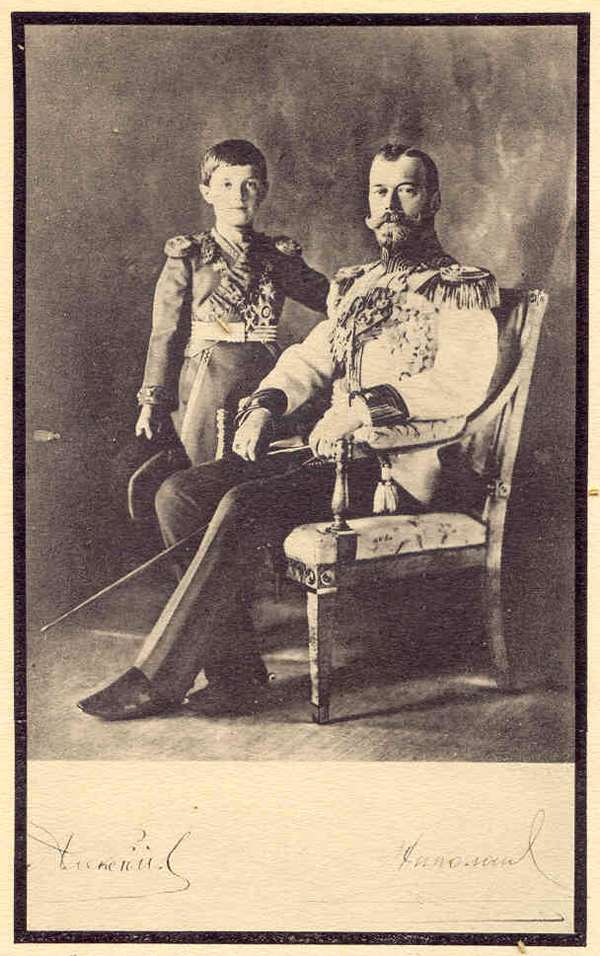
H. M. Emperor Nicholas II and H. I. H. Grand Duke Alexis, Heir to the Throne of Russia, photographed at Peterhof on the wedding-day of H. II. Prince John of Russia, of the Horse Guards, and H. R. H. Princess Helena of Serbia, daughter to H.M. King Peter 1 of Serbia. His Majesty is seen wearing the full dress uniform of a colonel of the Horse Guards, H. I. H. the Grand Duke that of an officer in the Imperial Family's Fusiliers. Under this photograph are. printed the words spoken by His Majesty on the day following the declaration of war, July 20th./August 2nd., 1914, at the Winter Palace, in St. Petersburg. "Russia, our Great Mother, has received the news that war has been declared upon us, quietly and with dignity. It is in this spirit, I am sure, that we shall wage and win this war, whatever it may be. I here solemn3y declare that I Will not make peace as long as the last of the enemy's soldiers has not left our country.
" Through you, representatives here assembled of My Guards and the troops of the Military District of St. Petersburg so dear to My heart, I now speak to all My Armies, welded together in heart and soul and strong as a granite wall, and I bless them in their warlike task. "
These grave words uttered by the last of the Emperors of Russia have been mainly responsible for His tragic fate, as was rightly emphasised hy H. I. Ii. the Grand Duke Dmitri of Russia in His speech delivered on April 26th., 1931: " To us these words spoken by our last Sovereign Colonel-in-Chief are sacred. In His determination to keep His plighted troth our Emperor unhesitatingly sacrificed not only His own life, but that of the whole Imperial Family. "

Facsimile Of an autograph note by Empress Anne of Russia ordering that the former "Leib Regiment" be henceforth named "Horse Guards " (1730). This document formed part of the collection belonging to the Horse Guards' Museum in St. Petersburg.

A Portrait of Empress Anne of Russia, who founded the regiment of the Horse Guards, reproduced for the first time in the present volume from a water-colour sketch by Hau, 1851, in the Jubilee Album of the regiment of the Chevalier-Guards.
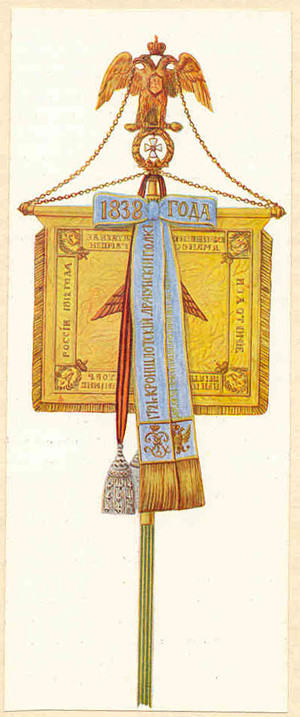
The last colours of the Horse Guards bearing the ribands of the Orders of St. Andrew and of St.George, conferred upon them in recognition of high feats of valour in the field.

A subaltern officer ol the Horse Guards in full dress uniform (1742-1762). A lithograph taken from a series of 25 coloured plates representing the various uniforms of the Horse Guards in the History ol the Horse Guards, by Annenkoff (1848).

Trooping of the colours of the Horse Guards on March 25th., 1836, regimental Commemoration Day, alien a review on foot lield by H. M. Emperor Nicholas II at the Great Regimental Riding School. The colours of the Horse Guards were usually kept at the Winter Palace.
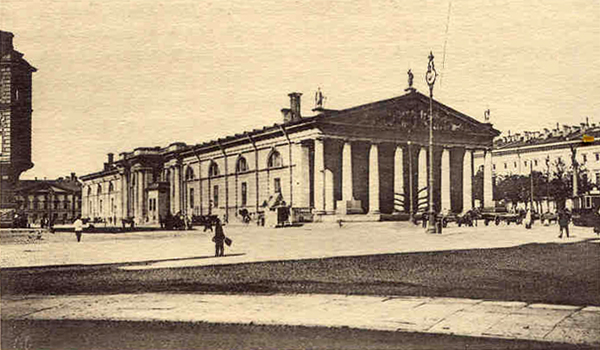
The Great Riding School of the Horse Guards in St. Petersburg, built by Guareughi. Facade looking on Alexander Gardens as it was in summer 1914.
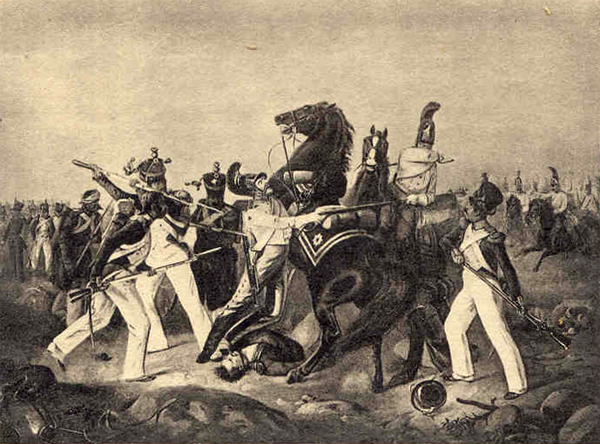
A feat of arms accomplished by the Horse Guards in the battle of Austerlitz (I805), from an oil painting by Charlemagne (1852) in the picture gallery ol the Horse Guards' Museum in St. Petersburg.
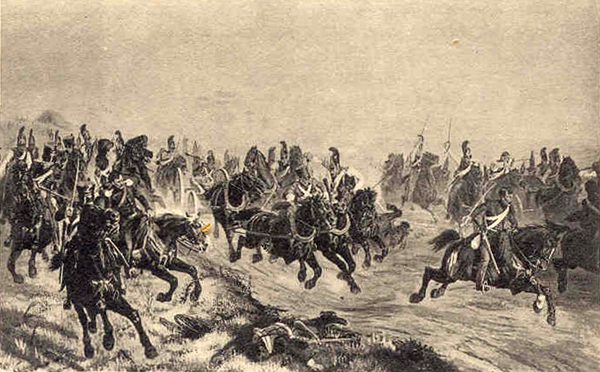
Pursuit by the Horse Guards of French artillery and mounted chasseurs at the battle of Polotzk, on Angust 6/18th., 1812, from an oil painting in the picture gallery of the Horse Guards' Museum in St. Petersburg.
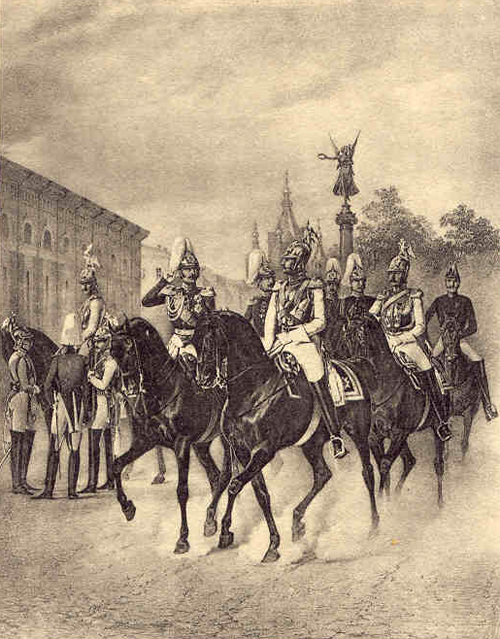
Emperor Nicholas I and the Heir Apparent, Grand Duke Alexander (later Emperor Alexander II) riding round the Horse Guards' regimental barracks. In the back-ground are to be seen the regimental Church and the Great Riding School. Reproduced from a coloured plate by Piratsky belonging to the Horse Guard' Museum in St. Petersburg.

Some of the uniforms worn by officers of the Horse Guards in 1856. Count Lambert, in command, is seen surrounded by officers; in the background the Circat Riding School, in St. Petersburg. A. Gobens inv. et del., Chevalier sculp.
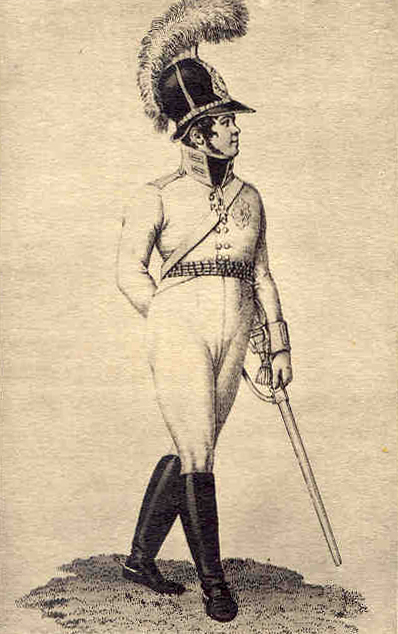
H. I. H. Grand Duke Constantine of Russia, Heir-Presumptive, Colonel-in-Chief of the Horse Guards from May 28th., 1800, till June 15th, 1831. Reproduced from a very rare German coloured engraving.

The Monument erected on the battlefield of Borodino near Moscow (1812) by the First Brigade, First Cavalry Division ol the Guards (Chevalier-Guards and Horse Guards to commemorate the hundredth anniversary of the battle (1912).

Some of the uniforms worn by officers of the " Leib Regiment " and the Horse Guards, from works by Wiskowaty and Annenkoff.

Plan of Hie bailie of Kauschen (East Prussia), fought on August 6 /19th., 1914, when a mounted charge by the Horse Guards resulted in the capture of two field guns. Tour ammunition waggons and an elevated observation post of the 2nd. German Landwehr Battery.

H. M. Emperor Nicholas II in conversation with Count W. de Freedericksz, Captain-in-Chief of the 4th. squadron ai the Horse Gnards, at Livadia, Crimea.

H. H, Prince John of Russia, of the Horse Guards, murdered by the bolsheviks at Alapaievsk in 1918. Photo 1881.
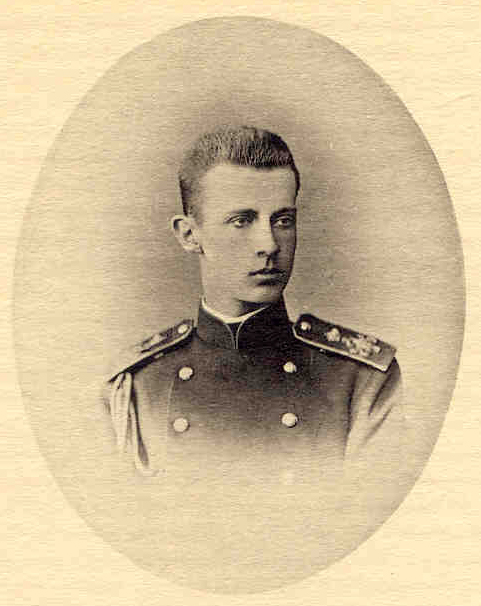
H. I. H. Grand Duke Dmitri of Russia, of the Horse Guards, murdered by the bolsheviks in 1918; from a photograph taken in 1881.
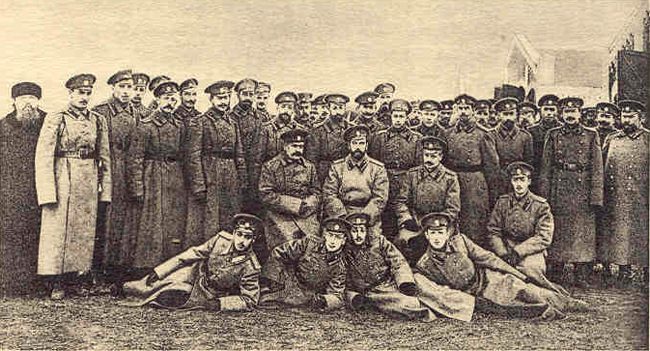
H. M. Emperor Nicholas II at Baranovichi, H.Q.G. of the Generalissimo H. I. H. Grand Duke Nicholas ol Russia, surrounded by officers of the Horse Guards. The Horse Guards did service at H.Q.G. during the autumn 1914.

H. I. H. Grand Dul;e Dmitri of Russia, President of Honour of the Association of Former Officers of t he Horse Guards. His Imperial Highness was placed on the rolls of the Horse Guards on the day of His birth, October 29th., 1891.
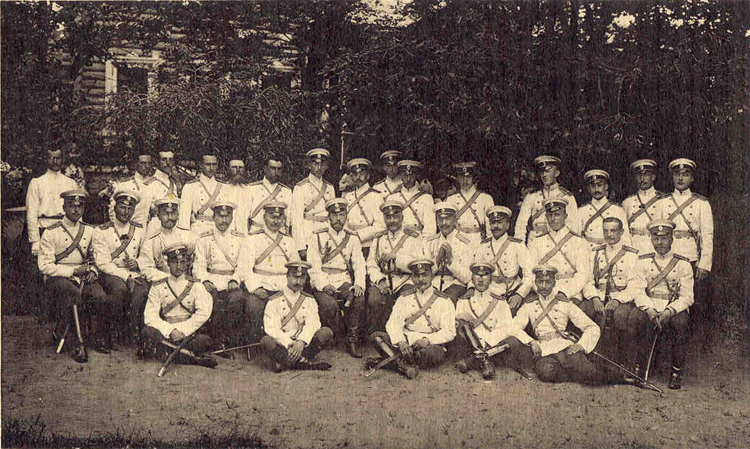
H. M. Emperor Nicholas II, surrounded by officers of the Horse Guards, in the garden of the Officers' Mess at Krasnoie Selo, after holding an inspection of squadron exercise, in 1906.
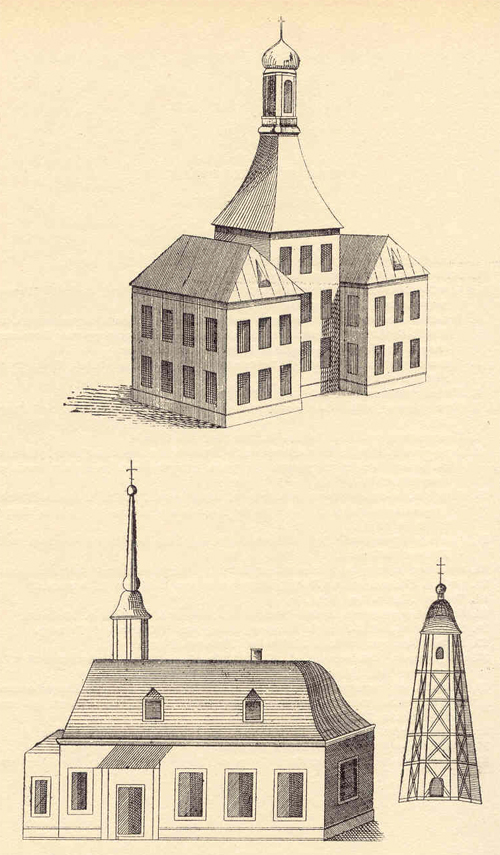
A sketch of regimental head-quarters and the first stone church of the Horse Guards. A sketch of the first provisional regimental church in the name of St. John the Baptist bought by the Horse Guards from lhe Archiepiscopal See in 1733 (Both sketches have breen reproduced from " A Description of St. Petersburg " by Bogdanoff, published in 1779).
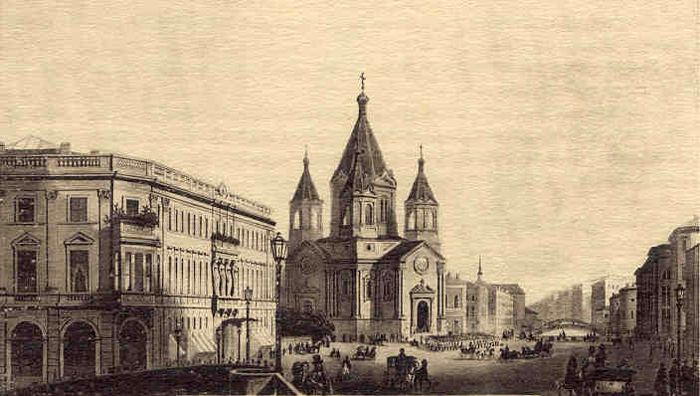
A view of the Cathedral of lhe Annunciation, the Horse Guards regimental Church, from a coloured lithograph by Daziaro. The cathedral was consecrated in 1849 and in it were kept all the old regimental colours and also those of a French infantry regiment captured by the Horse Guards in the baffle of Austerlitz (1805). The pillars in the aisle were hung with plates of gold on which were engraved the names of officers of ihc Horse Guards killed in action. The vestry of the cathedral may well be said to have bceu a veritable museum on account of the great number of ancient vestments and works of art contained herein. The high altar was made of pure silver. In the crypt were the tombs of two former commanders of the Horse Guards, Prince Orloff and Prince Golitzyn. The cathedral has been pulled down by the bolsheviks some time ago, and the fate of all the regimental relics it contained is unknown.
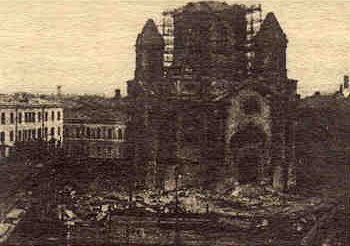
A view of the cathedral of the Annunciation being pulled down by the bolsheviks, from a photograph published on August 31st., 1929, in the " Illustriertes Blatt ", Frankfurt-on-Maine.
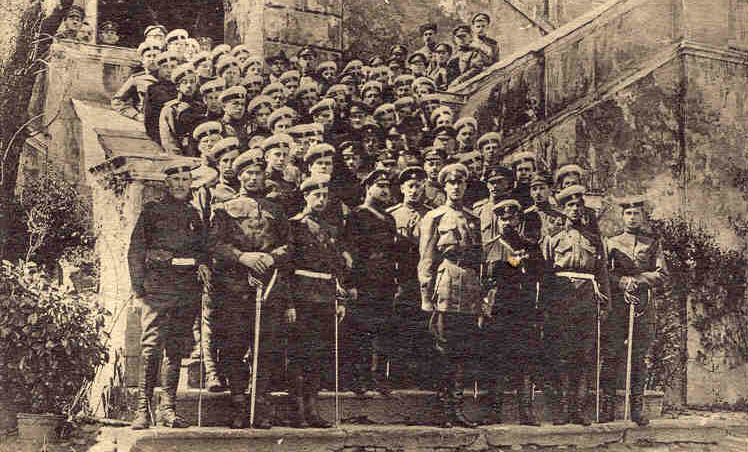
General the Baron de Wrangel and General Koutiepoff, surrounded by officers and men of the squadron of volunteers of the Horse Guards, at Constantinople, where they served as Personal Escort to the Commander in Chief of the Russian Army. The Baron dc Wrangell is seen wearing the while cross of the order of St. George; the officer with the beard is General Koutiepoff.
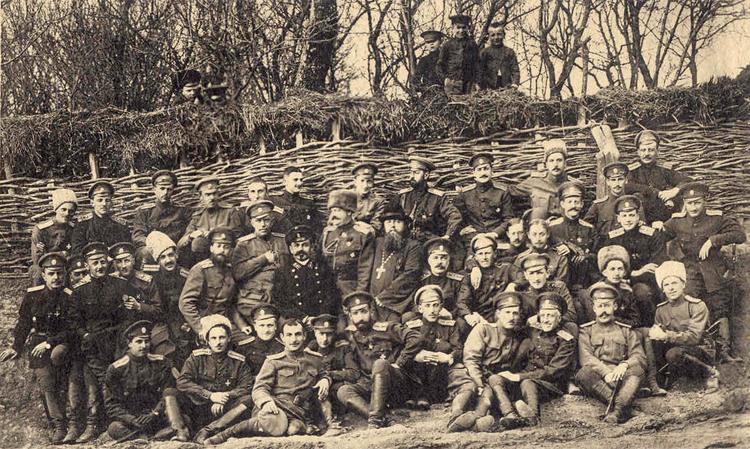
A group of officers of the Horse Guards photographed during the war on March 25th., 1916, regimental Commemoration Day, at the village of Ivankovtzy, near the town of Proskouroff.
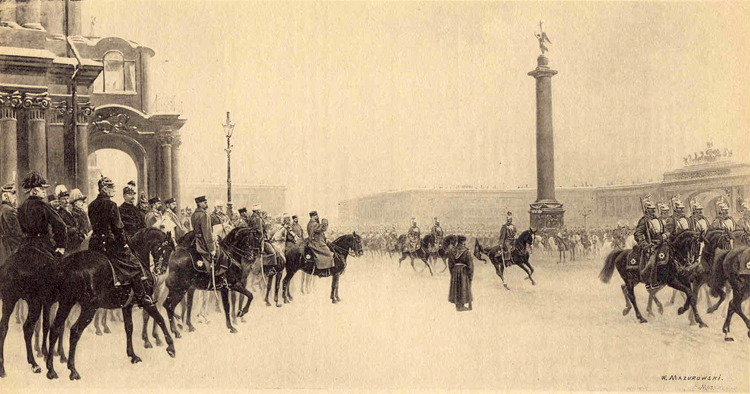
H. M. Emperor Alexander III reviewing the Horse Guards in Winter Palace Place, in St. Petersburg. At the head of the regiment is H. I.H. Grand Duke Paul of Russia, commander of the Horse Guards. Reproduced from an oil painting by Mazurowski belonging to the picture gallery of the Emperor Alexander III Museum, St. Petersburg.
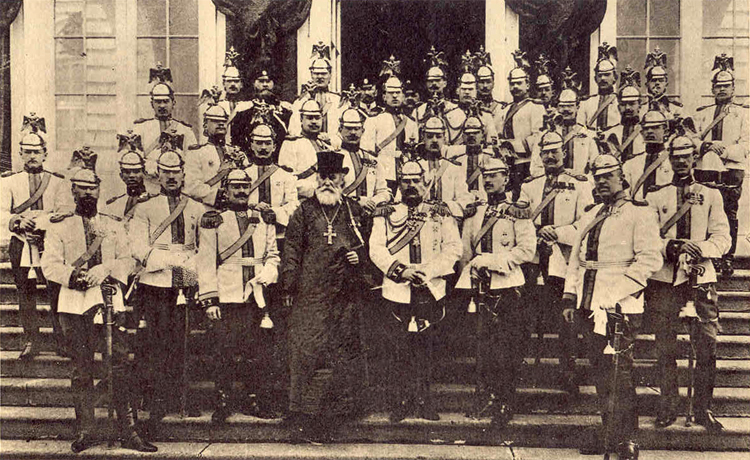
A group of officers of the Horse Guards in full dress uniform photographed outside the Great Catherine Palace at Tsarskoie Selo, after a review by H. M. the Emperor on March 25th.. 1909, regimental Commemoration Day.
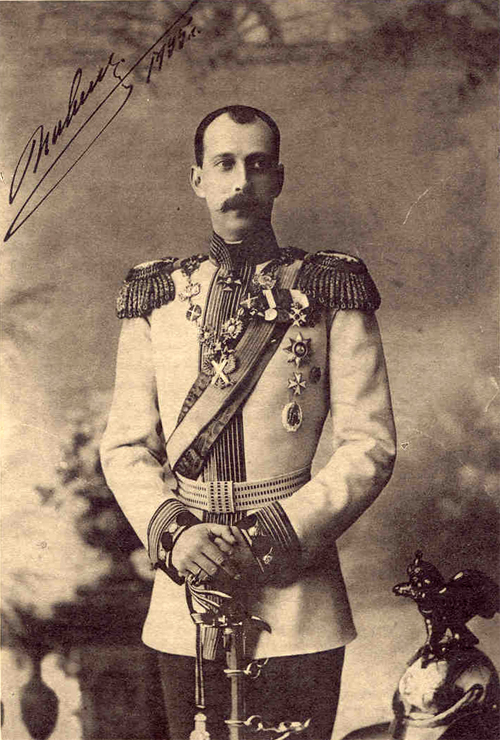
H. I. H. Grand Duke Paul of Russia who was in command of the Horse Guards from 1891 till 1896. He was the father of H. I. H. Grand Dyke Dmitri of Russia and was murdered by the bolsheviks in St. Petersburg in 1918.
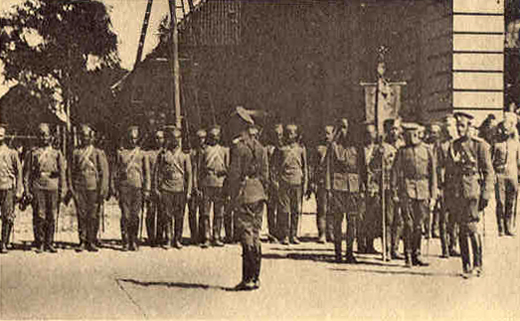
Trooping of the colours of the Horse Guards after a review at Insterburg (East Prussia) in August 1914. H. I. H. Grand Duke Dmitri of Russia is seen standing beside the standard-bearer.

A group of staff officers of the Horse Guards, photographed near Radom, in Poland, during the war.
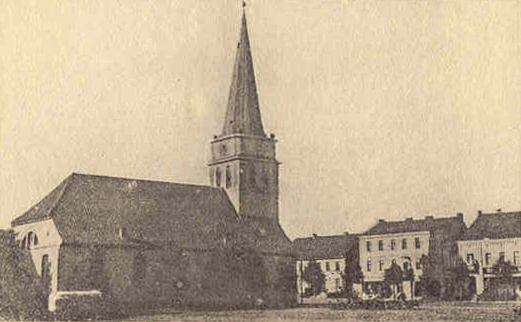
Market place and church at Gumbinnen, a town in East Prussia, through which the Horse Guards passed during the war.
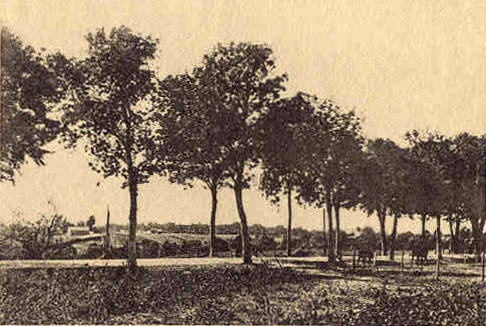
A view of the high road leading from the village ol Oppetlischken to that of Kraupischken (East Prussia), where a baltle was fough-on August 5/19th., 1914.

Captain the Baron de Wrangel sitting on one of the field guns taken from the Germans on August 6/19lh., 1914, when he led a charge of the 3rd. Squadron of the Horse Guards.
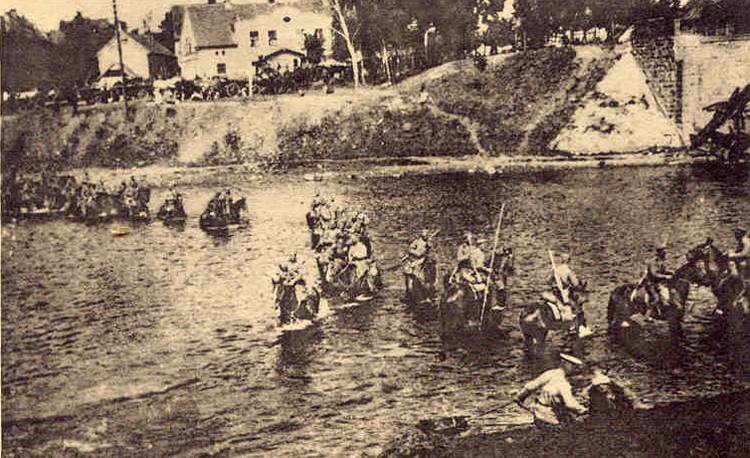
The Horse Guards fording a river near Friedland (1914).
